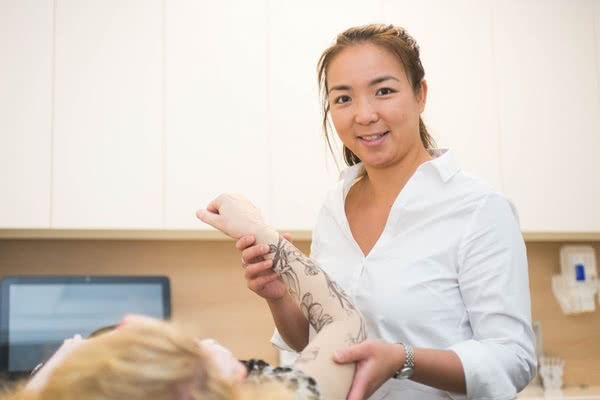Understanding lymphoedema17 Aug 2018

What is it?
Lymphoedema is a potential side effect of breast cancer treatments like surgery and radiotherapy. It’s the name for swelling and discomfort in the body due to damage to or removal of the lymph nodes.
Lymph is a fluid that circulates throughout the body, removing waste, bacteria, and other substances from tissue. Oedema is the build-up of excess fluid – in this case, too much lymph accumulating in one area. Lymph nodes, which filter or “clean” lymph, may be removed as the result of surgery or damaged during radiotherapy. This can result in oedema, as the remaining lymph nodes may be overwhelmed trying to filter the lymph.
Lymphoedema can appear months or even years after treatment ends, but early diagnosis and treatment can help manage the condition. At this time, there is no known cure for the condition, but specialists like Chris O’Brien Lifehouse lymphoedema therapist Jessica Poon can help patients manage the symptoms.
“It’s not such a well-known area of medicine and it is only just starting to get recognition from more and more health professionals. I find that the most difficult part of my job is making people aware of what lymphoedema is and who is at risk of getting it. That way we can identify and treat it early in a patient’s cancer journey,” she said.
Detection
Chris O’Brien Lifehouse offers early intervention screening for lymphoedema, assessment of new and chronic oedemas and education on prevention.
Swelling and discomfort usually occur in the arm and hand, but can sometimes affect the breast, underarm, chest, abdomen, and back. Prior to visible swelling, unusual sensations can happen like increased warmth or recurring tingling, ache, shooting pain or numbness.
Other warning signs include:
Feelings of fullness or heaviness in the hand, arm, chest, breast, or underarm
Tightness or decreased flexibility in the shoulder, hand, or wrist
Elbow tenderness
Slight puffiness or swelling in the arm, hand, chest, or breast, with a temporary indentation of the skin when pressure is applied
Veins or tendons in the hand are harder to see, the knuckles look less pronounced, or once-wrinkled skin looks smoother
Clothing and jewellery seems tighter
Asymmetry in the back (one side looks larger than the other)
Changes in skin texture or appearance, such as tightness, redness, hardening, rash or itching
Reducing risk
Active skin care, such as moisturising and sun protection, can help reduce the risk of developing lymphoedema. Regular, low-intensity exercise is also useful, as muscle movement increases lymph flow and reduces fluid accumulation.
Managing lymphoedema
While there is currently no known cure for the condition, there are treatments to reduce and control swelling, improve range of motion and prevent infections. These include skin care, gentle exercise, lymphatic drainage massage and use of compression garments and kinesiotape.
Learn more about lymphoedema therapy at Chris O'Brien Lifehouse.









